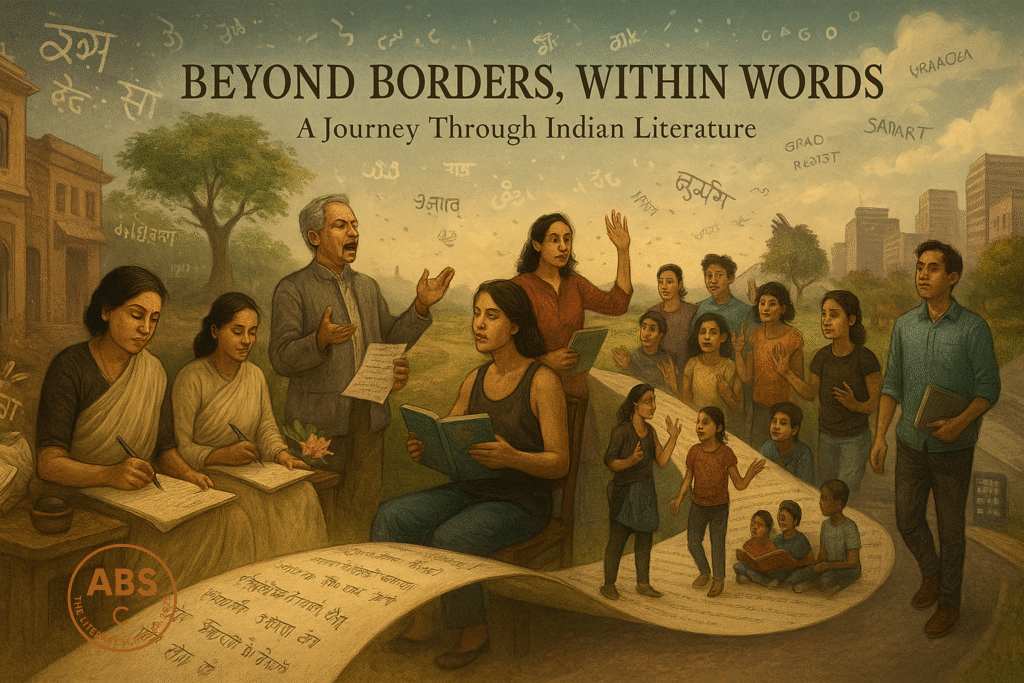From Ismat to InstaLit, from epics to edge cases—Indian English literature closes one circle, and dares another to begin
By ABS, The Literary Scholar, who believes the scroll never ends—only changes its ink, its tongue, and sometimes, its reader.
Section 1: Echoes of the Past
Before hashtags and hybrid forms, there were writers who had only paper, fire, and an unshakable need to speak. Many didn’t write in English—but their words now live here, translated, trembling, timeless.
Ismat Chughtai wrote about female desire, same-sex love, and Muslim identity in pre-Partition India with the kind of fearlessness that still gets you cancelled in certain WhatsApp groups.
“I write for those whose stories are never written.”
She was banned, branded obscene, and invited to more courtroom trials than literary salons. Yet she persisted—laughing all the way through Urdu’s most uncomfortable corners.
Mahasweta Devi wasn’t just a writer. She was a warrior in a cotton sari, documenting the lives of tribals, revolutionaries, and invisible citizens.
“The fears of the ruling class are always written into law.”
Her Draupadi still bleeds across university syllabi—demanding not your sympathy, but your reckoning.
U.R. Ananthamurthy’s Samskara gave us Brahminism rotting from within. A death, a feast, a scandal—and Kannada literature found its most elegant heretic.
Ambai (C.S. Lakshmi) wrote Tamil stories about love, body, language, and liberation—as if every word carried the memory of a thousand silences.
Bama’s Karukku split open Dalit Christianity with brutal honesty. She didn’t write to reform. She wrote to survive—and in doing so, tore through literary fences with barefoot grace.
And others:
Rajinder Singh Bedi, with his aching Urdu realism
Vaikom Muhammad Basheer, who made Malayalam fiction laugh and cry in the same breath
Sunil Gangopadhyay, who made Bengali sensuality shimmer on every page
They weren’t “Indian English writers”—but Indian English literature owes them everything. They gave us stories too fierce for footnotes.
Section 2: Where We Are Now
Now the scroll has become a screen. And literature? It lives in reels, recitations, newsletters, podcasts, memes, and litfests sponsored by airlines.
Welcome to the chaos—and chorus—of contemporary Indian storytelling.
Graphic novels arrived, full of myth and madness:
Amruta Patil reimagined Mahabharata and Devi lore with breathtaking visual lyricism
Appupen built dystopias darker than news
Sarnath Banerjee doodled politics, nostalgia, and identity into the most elegant comics
Spoken word poets took the stage:
Priya Malik, Aranya Johar, Megha Rao turned pain into performance
Instagram saw poems under 10 lines that broke 1,000 hearts per scroll
Digital spaces—Scroll, The Wire, The Curious Reader, India Booked—became new-age addas, where reviews, rants, reflections, and revolutions quietly brewed.
Young Adult fiction became bold, bilingual, and beautiful:
Born Confused by Tanuja Desai Hidier remains a diaspora anthem
Paro Anand, Neel Patel, and new voices told coming-of-age stories laced with caste, queerness, and cultural conflict
Even Bookstagram made literature cool again. #DalitVoices. #TranslatedTuesday. #ReadWomenWriters. Suddenly, algorithms joined the canon.
Where are we now? Everywhere. On paper. On platforms. In pixels. In poems that live in pockets.
Section 3: What We Read Next
Let’s rewind—before we exhale.
We began in IndyLit 1, with Raja Rao, R.K. Narayan, and Mulk Raj Anand—the trinity of English-wielding freedom-dreamers.
We heard the voices of Tagore, Gandhi, Sarojini Naidu, and Ambedkar—who turned prose into protest.
Then came Kamala Markandaya, Anita Desai, and Nayantara Sahgal—writing inner storms in postcolonial stillness.
Rushdie burst the dam. Roy drowned us in lyrical loss. Ghosh charted history while Seth structured serenity.
Diaspora voices—Lahiri, Mistry, Mukherjee—wrote of longing and loss, in airports and kitchens.
Then came the rule-breakers and rage-makers:
Kandasamy, Murugan, Zaidi, Thayil, Pinto, Temsula Ao
We met the performers and plot-twisters—from Bhagat to Karnad, Sudha Murty to Amish.
And we held space for the heretics, hybrids, heartbreakers who refused to write India with a capital I.
The Final Scroll (But Not the Last Story)
So where does Indian English literature go from here?
Anywhere it pleases.
It is no longer one story. It is a chorus, a map with multiple scales, a language with stolen syllables and sacred silences.
It is the queer poet from Manipur.
The self-published Dalit teenager.
The grandmother writing her memoir in Google Docs.
The spoken-word artist rhyming rage into TikTok.
The academic quietly footnoting rebellion.
The reader who finally found her reflection in a translation from a tongue she never knew she missed.
Indian English literature no longer belongs to a few. It belongs to anyone who dares to tell the truth—no matter how flawed the grammar, or how fragile the page.
As ABS folds this final scroll—not with finality, but with fire—there is no moral. Just this:
The story isn’t over. The language isn’t fixed. The scroll is only paused.
Signed,
ABS
The Literary Scholar
Who read the canon, rewrote the margins, and believes that in Indian English literature—no one writes the last word alone

Share this post / Spread the witty word / Let the echo wander / Bookmark the brilliance
